Guide to the 12 Seasonal Color System: Pt. 1: Color Dimensions and the 4 and 12 Seasons
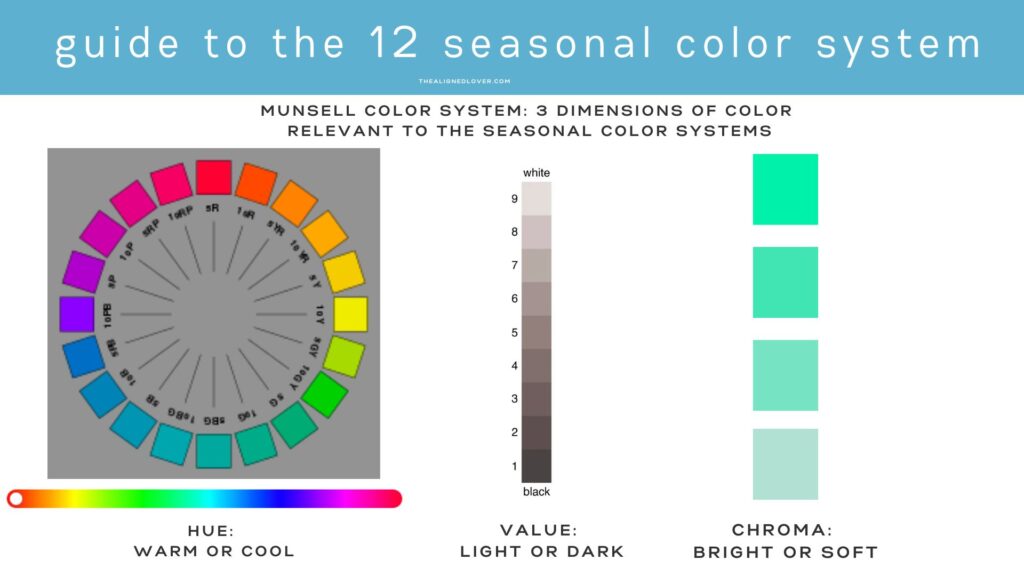
If you are interested in exploring or utilizing the wonderful 12 Season Color System but feel overwhelmed with the terminology, this post is for you! I’ll explain the underlying theory and color dimensions in a way that is relevant to the 12 Seasonal Color system so that you can familiarize yourself with these very important concepts and hopefully recognize them all around you. I’ll also explain how the 12 Season Color system stems and differs from the 4 Season Color system. Lastly, I’ll go over all 12 Seasons in terms of color qualities and show you the flow of attributes that makes this system much easier to navigate.
I will be referencing the color dimensions from the fascinating Munsell Color System.
To help you decode ANY color system, check out my virtual guide on navigating the world of personal color: https://thealignedlover.com/product/virtual-guide-navigating-the-world-of-seasonal-color/
Color Dimension #1: Hue
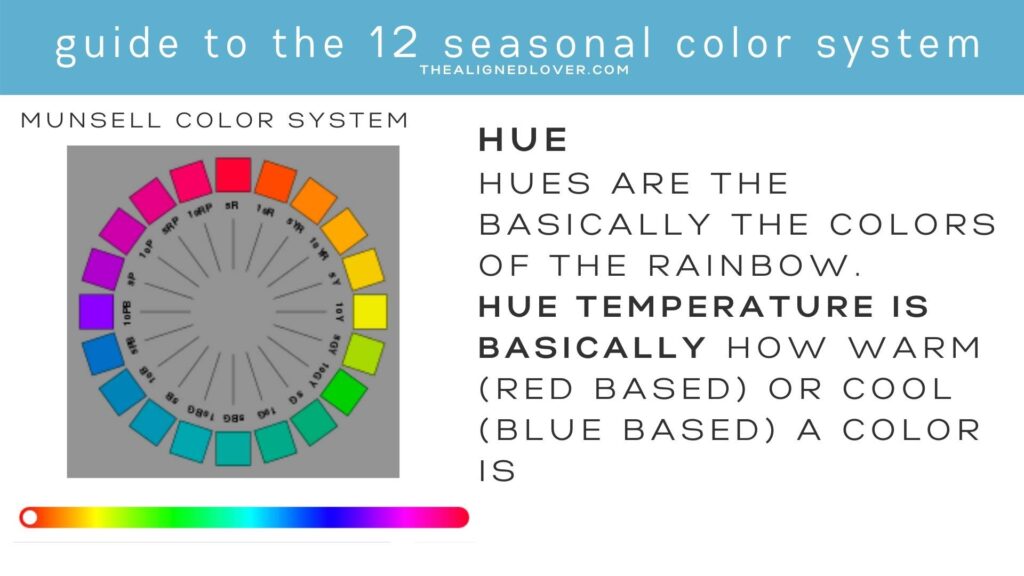
The first color dimension is hue- any given discernible color of the rainbow or visual spectrum. In the Munsell Color System, the hues are divided into principal and intermediary colors, but that isn’t so relevant to the 12 Season Color system.
What IS relevant is hue temperature- how warm or cool a color is.
Hue Temperature
Hue temperature is easy to visualize with the rainbow scale. Warmer or red based colors are closer to the red end of the spectrum, and cooler or blue based colors are closer to the blue end of the spectrum. Generally, the warmer colors include red, yellow, orange, and green while the cooler colors include blue-green, blue, purple, and pink.
Remember, hue temperature is relative, as you’ll see below. 2 colors that occupy the green region can have very different positions.
For example, the yellow-green below is much more close to the red end of the spectrum and has an obvious yellow base. The mint green is much closer to the blue end of the spectrum and has more of a turquoise base.
The same concept applies to the yellows below. The mustard yellow on the left is very orange based and close to red, whilst the icy yellow is much closer to green.
Another important note is that hue temperature is best appraised when looking at a cohesive color palette. A palette may have all of the possible main hues (red, yellow, green, blue, purple, pink) but those hues will likely fall toward one end of the spectrum. Also important to note that the color palettes of any seasonal color system are relative to one another and that appraising them in isolation is less insightful.
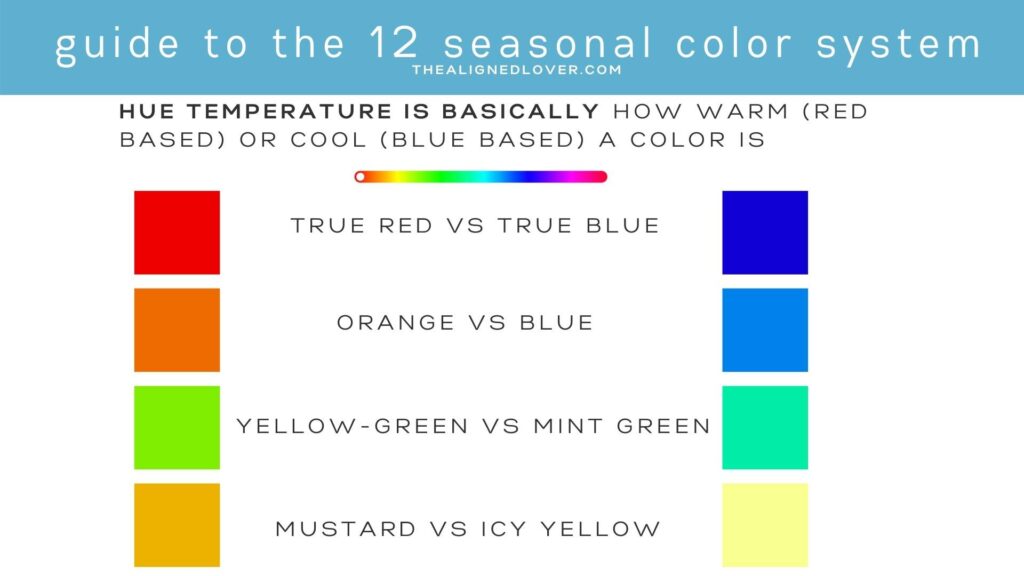
Color Dimension #2: Value
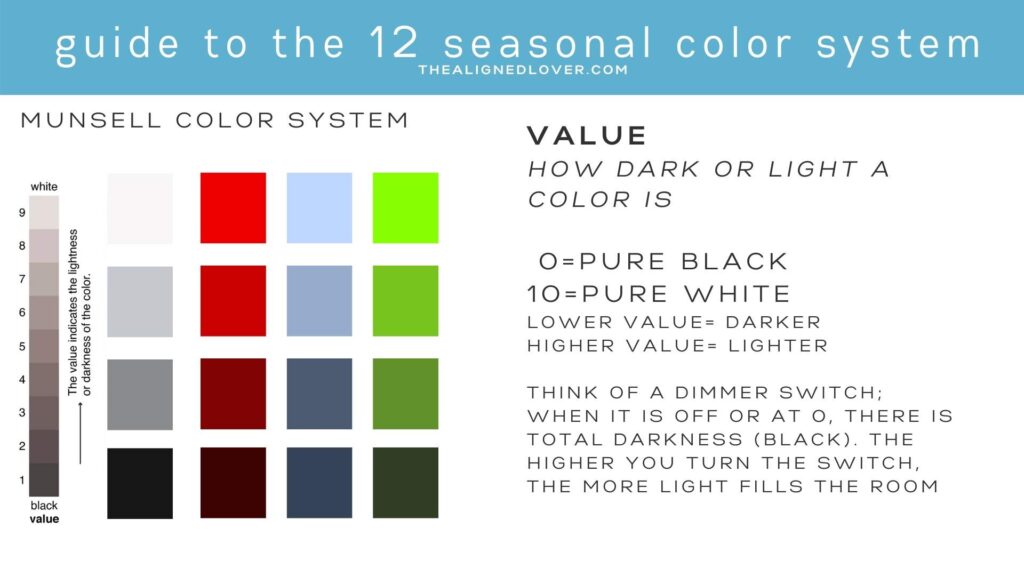
The second color dimension is value- how light or dark a color is. When value is low, the color has more black or darkness to it. When value is high, the color has more white or lightness to it. To remember this concept, imagine a dimmer switch. When the dimmer switch is off, the room is completely dark. When the dimmer switch is turned all the way up, the room has the maximum amount of light.
Color Dimension #3: Chroma
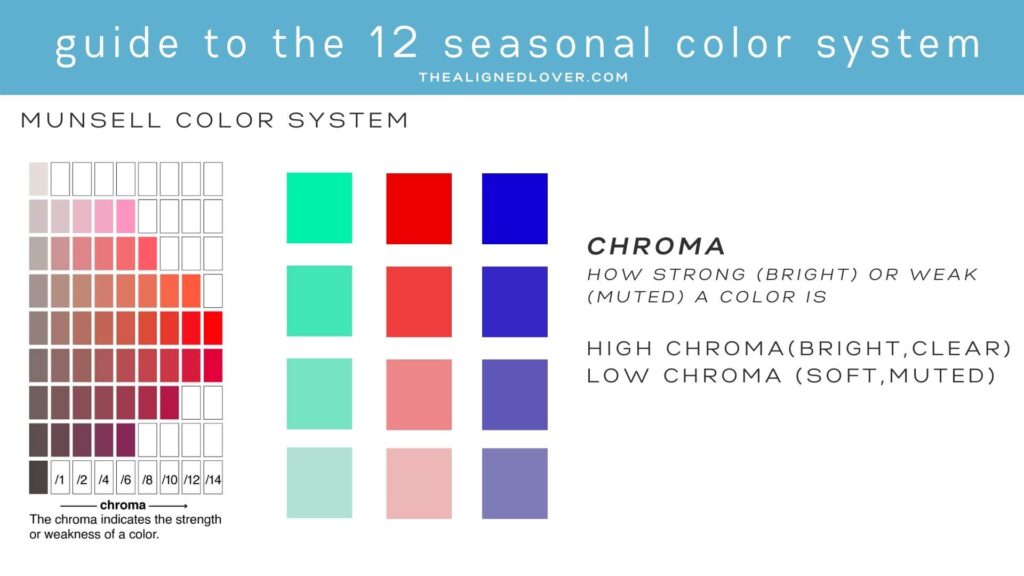
The last color dimension is chroma- how strong (bright, clear) or weak (soft, muted) a color is. The higher the chroma, the more bright or intense the color is. The lower the chroma, the closer to grey.
The 4 Season Color System
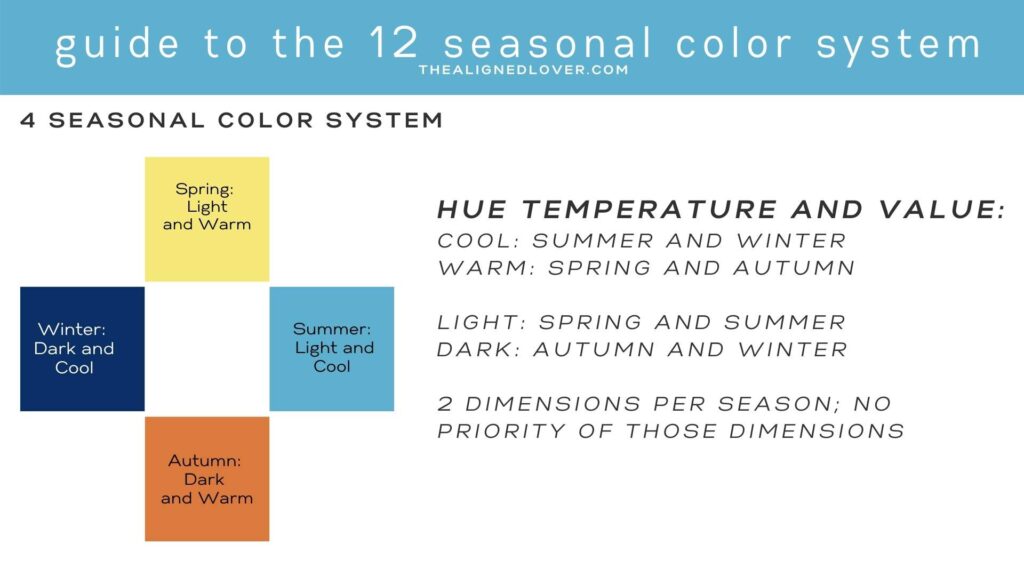
To better understand the 12 Season Color system, let us take a look at the more fundamental 4 Season Color system.
The 4 Season Color system uses 2 color dimensions- hue temperature and value, and assigns a combination of the two to each season.
Note that there is no hierarchy or dominant color dimension within each season. For example, Summer is Light and Cool, presuming lightness and coolness are in equal measure. There is no distinction between palettes that are first and foremost light and then cool, or vice versa.
To clarify, a color palette that prioritizes lightness over coolness will have colors that emphasize the lightness while remaining in the cooler range of colors. More will be revealed as we go through this series.
The 12 Season Color System
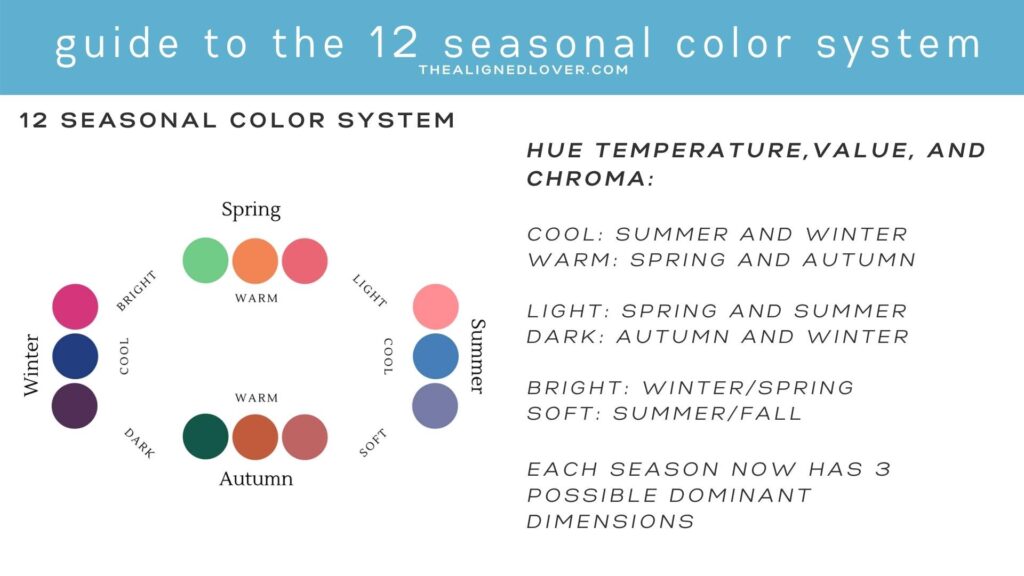
The 12 Seasonal Color system uses the same qualities as the 4 Season Color system, but adds chroma and a hierarchy. Each season has 3 subsets, with each subset having 2 qualities.
For example, Spring is still Warm and Light overall. True Spring is Warm and then Light. Flip that hierarchy, and you have Light Spring which is Light and Warm. On the other end of Spring is Bright Spring, which is Bright and Warm.
Notice that on either side of each True Season (the middle of each season), there are “transition” seasons that share a common color attribute with their neighbor from a separate season. For example, Light Spring is Light then Warm. It’s neighbor, most commonly called its sister palette, is Light Summer which is Light then Cool.
Also note that True Summer and True Autumn have different color attributes than that of their 4 Season Color. True Summer is Cool then Soft in the 12 Season Color system, whereas Summer is Cool and Light in the 4 Season Color system. True Autumn is Warm then Muted in the 12 Season Color system, whereas Autumn is Warm and Dark in the 4 Season color system.
That being said, True Spring and True Winter retain the same qualities of the 4 Season Color system. True Spring is still Warm and Light and True Winter is still Cool and Dark.
It is best to forget the nuances of the 4 Season Color system when learning the 12 Season color system to avoid confusion.
Qualities of the 12 Seasonal Color System

To better flesh out the qualities and hierarchies of each season, their traits are listed above.
4 Season Color System vs 12 Season Color System

Here is another visualization of the 4 vs 12 Season Color Palette. My advice is to remember the dimensions of the 4 Season color system to establish quicker associations that lay a solid foundation for the 12 Season Color system.
In the next entry of this series, we will look at color dimensions as they apply to palettes and overall physical coloring.
FAQ: 12 Seasonal Color System – Color Dimensions and the 4 vs 12 Seasons
Q: What is the 12 Seasonal Color System and why is it important?
A: The 12 Seasonal Color System is an advanced framework that expands on the traditional 4 Season Color system by including three color dimensions: hue, value, and chroma. It helps individuals identify their most flattering colors for wardrobe, makeup, and accessories by considering lightness/darkness, warmth/coolness, and brightness/mutedness. This system makes it easier to navigate and harmonize personal coloring.
Q: What are the three color dimensions in the 12 Season Color System?
A: The three key color dimensions are:
- Hue: The basic color family (red, yellow, blue, etc.) and its temperature (warm or cool).
- Value: How light or dark a color is.
- Chroma: The intensity or saturation of a color, ranging from muted/soft to bright/clear.
Understanding these dimensions allows you to see how palettes interact and which shades enhance your natural coloring.
Seasonal Color System FAQ
Q: How does the 12 Season Color System differ from the 4 Season Color System?
A: While the 4 Season system uses hue temperature and value (light/dark, warm/cool), the 12 Season system adds chroma and a hierarchy of attributes. Each True Season in the 12 Season system has three subsets with distinct qualities, creating smoother transitions between seasons and a more precise color framework.
Q: What are True Seasons, Transition Seasons, and Sister Palettes?
A: True Seasons (like True Spring or True Summer) are the core palettes in the 12 Season system. Transition Seasons share attributes with neighboring True Seasons to create continuity, and sister palettes are neighboring seasons that balance overlapping traits. For example, Light Spring transitions to Light Summer, creating a harmonious flow of colors.
Q: How do True Summer and True Autumn differ from the 4 Season system?
A: True Summer in the 12 Season system is Cool then Soft, whereas Summer in the 4 Season system is Cool and Light. True Autumn is Warm then Muted, whereas Autumn in the 4 Season system is Warm and Dark. This hierarchy reflects the dominant color quality first, then secondary traits, providing more precise guidance for styling and color selection.
Q: Why is understanding hue temperature important in the 12 Seasonal Color System?
A: Hue temperature determines whether a color reads as warm (yellow/red-based) or cool (blue-based). Assessing it in isolation can be misleading; it’s most accurate when viewing a cohesive color palette. Recognizing hue temperature helps you choose clothing and makeup that harmonize with your natural tones.
Q: How can I learn to navigate and apply the 12 Seasonal Color System effectively?
A: Start by familiarizing yourself with the three color dimensions—hue, value, and chroma—and how they combine in True Seasons and transition palettes. Observing the relationships between seasons, as explained in this guide, will help you identify your personal color profile more confidently.
Q: How can I get personalized guidance for my colors using the 12 Seasonal Color System?
A: You can explore my Virtual Guide to Navigating the World of Seasonal Color for step-by-step instructions on understanding seasonal color theory. For tailored, individual guidance, my In-Depth Color Analysis service provides personalized wardrobe, accessory, and makeup recommendations based on your unique coloring.
xx
Nona
